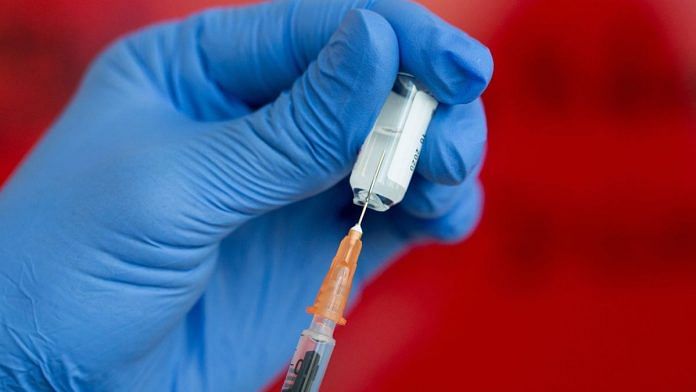Bengaluru: Scientists are developing a potential mRNA-based Covid vaccine that could offer high levels of protection at very low doses.
The technology, called self-amplifying RNA, or saRNA, works on the same principle as the Messenger RNA or mRNA vaccines, which offer Covid protection without bringing any part of the virus into the body (shots developed by US firms Moderna and Pfizer are examples).
As the name suggests, it is based on the RNA molecule replicating itself inside the body, which enables the vaccine to be effective at very low doses, offering a huge advantage in terms of scalability of production and rollout.
Imperial College London is one of the institutions working on developing saRNA vaccines, while the American company Arcturus Therapeutics is set to initiate its trial shortly.
No vaccine employing the technology has currently been approved for human use just yet, but trials are under way.
The researchers at Imperial College have just concluded Phase 1 human trials on 192 participants who were administered different doses. According to the team, while the vaccine helped produce antibodies in 87 per cent of the participants (establishing immunogenicity), and there were few side-effects (establishing safety), the resulting immune response was mixed.
The trial data, currently published as a pre-print, has been submitted to the journal Lancet for peer-review.
“Global demand for Covid-19 vaccines will remain high in the coming decade, given the emergence of lethal SARS-CoV-2 escape-variants, and expected requirement for booster vaccination,” Professor Robin Shattock, who leads Imperial’s Covid-19 vaccine project, was quoted as saying in a statement on the institute’s website.
“We have shown the saRNA technology is safe and can generate an immune response. We are now refining the Imperial saRNA platform to develop vaccines for a variety of other infectious diseases.”
Also Read: No need to stop breastfeeding, study tells mothers who have received mRNA Covid shots
How does saRNA work?
RNA vaccines work on the principle of the messenger RNA. This is the molecule that is delivered by the vaccine into the human body. The molecule carries ‘instructions’ to encode for or produce a “harmless piece” of the spike glycoprotein present on the surface of the coronavirus.
Once the ‘instructions’ are ‘read’ and the protein is expressed or produced, the mRNA molecule disintegrates.
The spike protein produced is an antigen, which the patrolling immune system cells recognise as not belonging to the body. The immune system then mounts a response against the protein, which causes it to do the same if it subsequently encounters the virus.
Since the vaccine does not contain any part of the actual virus, it is considered safer than other kinds of attenuated, killed, vector, or subunit vaccines.
With saRNA, the RNA not only encodes for the spike protein, but also encodes for a polymerase or an enzyme that then produces a copy of the RNA molecule. The process then repeats exponentially, resulting in a high protein expression or production of spike protein. This, theoretically, leads to an improved response and thus requires a low dose during administration.
Also Read: mRNA vaccines could cause heart inflammation in rare cases, studies in JAMA suggest
Human trials
saRNA vaccines came to be developed quite rapidly. The Imperial College candidate, LNP-nCoVsaRNA, was tested on 192 participants aged between 18 and 45 in the first-in-human trials. They were given two doses four or 14 weeks apart, and received a mix of six different dosages.
The resulting immune response was mixed, with some generating a robust response while others yielding a weak one. However, about 87 per cent of the participants produced antibodies. There were no allergic reactions and barely any side effects, with muscle pain being the most common one, the researchers said.
The team is currently working on its second iteration of the vaccine that aim to improve immune response and make the vaccine more optimal at low doses by enhancing the level of RNA expression, as well as refine it for other diseases.
Further trials are required to establish efficacy as well as effects in population outside the age and demographic bracket currently tested.
“The approach is emerging as one of the great scientific advances of the pandemic, with the ultra-low dose offering three key advantages. The first is the potential to manufacture a huge amount — one litre of reaction material can produce up to one million doses.
“The second advantage of a lower dose is the reduced likelihood of side effects. Finally, a low dose vaccine opens up the possibility of combining the Covid-19 vaccine with other vaccines. We may now need annual vaccines against Covid-19, and a lower dose makes combination with other vaccines, such as the flu vaccine, more feasible.”
Self-amplifying RNA vaccines offer numerous benefits, and all advantages of the mRNA vaccines apply to saRNA shots.
In the development of nucleic acid vaccines, RNA shots have overtaken DNA vaccines due to their target: RNA needs to only enter a cell or the cytoplasm, while DNA needs to enter into its nucleus by crossing the protective nuclear membrane. There are no approved DNA vaccines yet.
The flexible nature of the platform means RNA vaccines can be modified to quickly be effective against newer variants. They can also be beneficial against other diseases such as influenza, where vaccines are updated each year to keep up with the fast evolving virus. saRNA could potentially also be beneficial for research into other vaccines, including those for HIV and cancer.
(Edited by Sunanda Ranjan)
Also Read: You thought coronavirus is our newsmaker of 2020? No, it’s science-made mRNA, its nemesis






